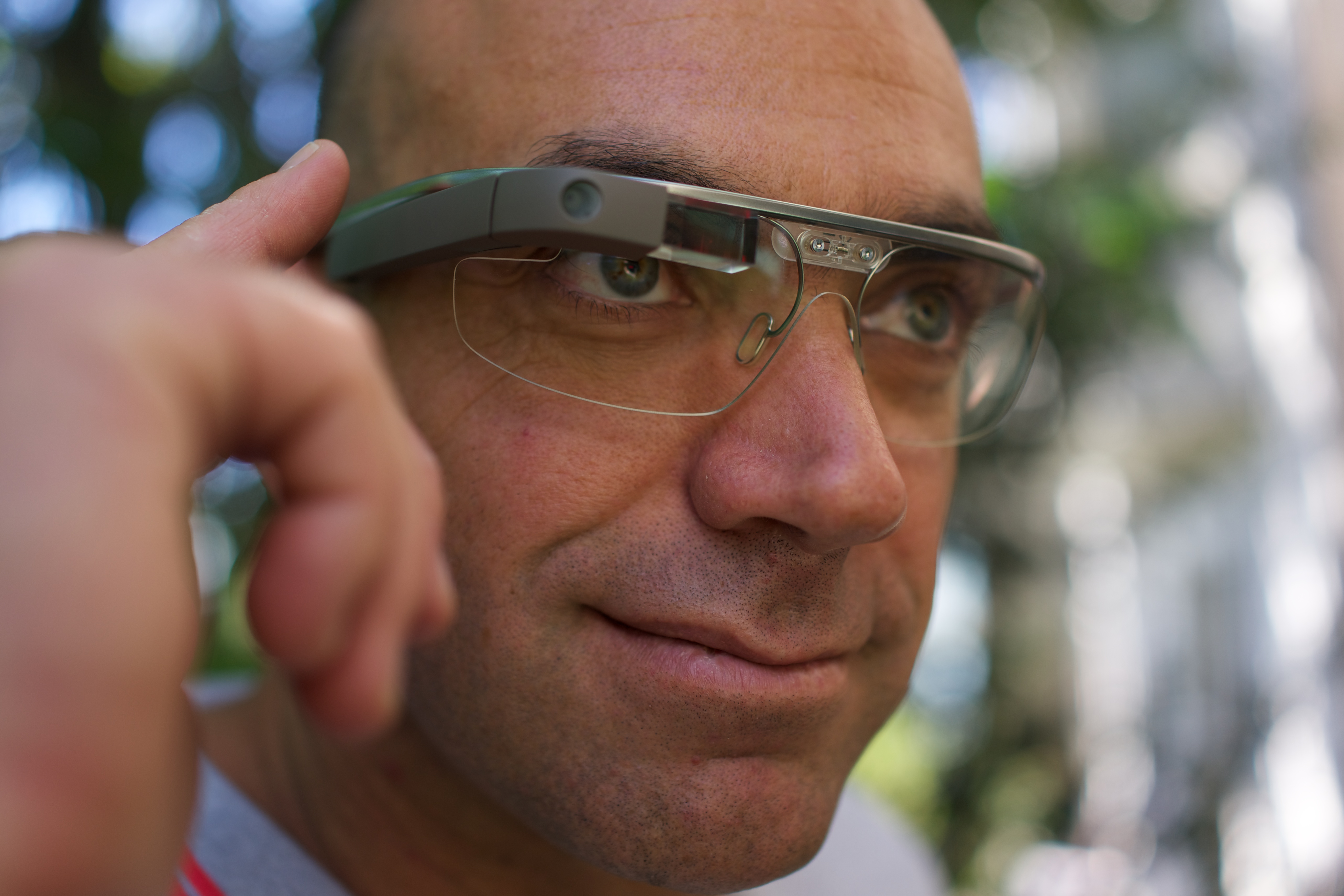|
Virtual Retinal Display
A virtual retinal display (VRD), also known as a retinal scan display (RSD) or retinal projector (RP), is a display technology that draws a raster display (like a television) directly onto the retina of the eye. History In the past similar systems have been made by projecting a defocused image directly in front of the user's eye on a small "screen", normally in the form of large glasses. The user focused their eyes on the background, where the screen appeared to be floating. The disadvantage of these systems was the limited area covered by the "screen", the high weight of the small televisions used to project the display, and the fact that the image would appear focused only if the user was focusing at a particular "depth". Limited brightness made them useful only in indoor settings as well. Only recently a number of developments have made a true VRD system practical. In particular the development of high-brightness LEDs have made the displays bright enough to be used during t ... [...More Info...] [...Related Items...] OR: [Wikipedia] [Google] [Baidu] |
Virtual Retinal Display Diagram
Virtual may refer to: * Virtual (horse), a thoroughbred racehorse * Virtual channel, a channel designation which differs from that of the actual radio channel (or range of frequencies) on which the signal travels * Virtual function, a programming function or method whose behaviour can be overridden within an inheriting class by a function with the same signature * Virtual machine, the virtualization of a computer system * Virtual meeting, or web conferencing * Virtual memory, a memory management technique that abstracts the memory address space in a computer * Virtual particle, a type of short-lived particle of indeterminate mass * Virtual reality (virtuality), computer programs with an interface that gives the user the impression that they are physically inside a simulated space * Virtual world, a computer-based simulated environment populated by many users who can create a personal avatar, and simultaneously and independently explore the world, participate in its activities and co ... [...More Info...] [...Related Items...] OR: [Wikipedia] [Google] [Baidu] |
Fujitsu
is a Japanese multinational information and communications technology equipment and services corporation, established in 1935 and headquartered in Tokyo. Fujitsu is the world's sixth-largest IT services provider by annual revenue, and the largest in Japan, in 2021. The hardware offerings from Fujitsu are mainly of personal and enterprise computing products, including x86, SPARC and mainframe compatible server products, although the corporation and its subsidiaries also offer a diversity of products and services in the areas of data storage, telecommunications, advanced microelectronics, and air conditioning. It has approximately 126,400 employees and its products and services are available in approximately 180 countries. Fujitsu is listed on the Tokyo Stock Exchange and Nagoya Stock Exchange; its Tokyo listing is a constituent of the Nikkei 225 and TOPIX 100 indices. History 1935 to 2000 Fujitsu was established on June 20, 1935, which makes it one of the oldest operating ... [...More Info...] [...Related Items...] OR: [Wikipedia] [Google] [Baidu] |
Multimodal Interaction
Multimodal interaction provides the user with multiple modes of interacting with a system. A multimodal interface provides several distinct tools for input and output of data. Introduction Multimodal human-computer interaction refers to the "interaction with the virtual and physical environment through natural modes of communication", This implies that multimodal interaction enables a more free and natural communication, interfacing users with automated systems in both input and output. Specifically, multimodal systems can offer a flexible, efficient and usable environment allowing users to interact through input modalities, such as speech, handwriting, hand gesture and gaze, and to receive information by the system through output modalities, such as speech synthesis, smart graphics and other modalities, opportunely combined. Then a multimodal system has to recognize the inputs from the different modalities combining them according to temporal and contextual constraintsCasche ... [...More Info...] [...Related Items...] OR: [Wikipedia] [Google] [Baidu] |
Display Technology
A display device is an output device for presentation of information in visual or tactile form (the latter used for example in tactile electronic displays for blind people). When the input information that is supplied has an electrical signal the display is called an ''electronic display''. Common applications for ''electronic visual displays'' are television sets or computer monitors. Types of electronic displays In use These are the technologies used to create the various displays in use today. * Liquid crystal display (LCD) ** Light-emitting diode (LED) backlit LCD ** Thin-film transistor (TFT) LCD ** Quantum dot (QLED) display * Light-emitting diode (LED) display ** OLED display ** AMOLED display ** Super AMOLED display Segment displays Some displays can show only digits or alphanumeric characters. They are called segment displays, because they are composed of several segments that switch on and off to give appearance of desired glyph. The segments are usua ... [...More Info...] [...Related Items...] OR: [Wikipedia] [Google] [Baidu] |
IEEE Spectrum
''IEEE Spectrum'' is a magazine edited by the Institute of Electrical and Electronics Engineers. The first issue of ''IEEE Spectrum'' was published in January 1964 as a successor to ''Electrical Engineering''. The magazine contains peer-reviewed articles about technology and science trends affecting business and society. In 2010, ''IEEE Spectrum'' was the recipient of ''Utne Reader'' magazine's Utne Independent Press Award for Science/Technology Coverage. In 2012, ''IEEE Spectrum'' was selected as the winner of the National Magazine Awards' "General Excellence Among Thought Leader Magazines" category. References External links * {{Official website, https://spectrum.ieee.org/ Monthly magazines published in the United States Science and technology magazines published in the United States Engineering magazines Spectrum A spectrum (plural ''spectra'' or ''spectrums'') is a condition that is not limited to a specific set of values but can vary, without gaps, across a ... [...More Info...] [...Related Items...] OR: [Wikipedia] [Google] [Baidu] |
Visual Prosthetic
A visual prosthesis, often referred to as a bionic eye, is an experimental visual device intended to restore functional vision in those with partial or total blindness. Many devices have been developed, usually modeled on the cochlear implant or bionic ear devices, a type of Neuroprosthetics, neural prosthesis in use since the mid-1980s. The idea of using electrical current (e.g., electrically stimulating the retina or the visual cortex) to provide sight dates back to the 18th century, discussed by Benjamin Franklin, Tiberius Cavallo, and Charles LeRoy. Biological considerations The ability to give sight to a blind person via a bionic eye depends on the circumstances surrounding the loss of sight. For retinal prostheses, which are the most prevalent visual prosthetic under development (due to ease of access to the retina among other considerations), patients with vision loss due to degeneration of Photoreceptor cell, photoreceptors (retinitis pigmentosa, choroideremia, geograph ... [...More Info...] [...Related Items...] OR: [Wikipedia] [Google] [Baidu] |
Smartglasses
Smartglasses or smart glasses are eye or head-worn wearable computers that offer useful capabilities to the user. Many smartglasses include displays that add information alongside or to what the wearer sees. Alternatively, smartglasses are sometimes defined as glasses that are able to change their optical properties, such as smart sunglasses that are programmed to change tint by electronic means. A pair of smartglasses can be considered an augmented reality device if it performs pose tracking. Superimposing information onto a field of view is achieved through an optical head-mounted display (OHMD) or embedded wireless glasses with transparent heads-up display (HUD) or augmented reality (AR) overlay. These systems have the capability to reflect projected digital images as well as allowing the user to see through it or see better with it. While early models can perform basic tasks, such as serving as a front end display for a remote system, as in the case of smartglasses utiliz ... [...More Info...] [...Related Items...] OR: [Wikipedia] [Google] [Baidu] |
Physics Of The Future
''Physics of the Future: How Science Will Shape Human Destiny and Our Daily Lives by the Year 2100'' is a 2011 book by theoretical physicist Michio Kaku, author of ''Hyperspace'' and ''Physics of the Impossible''. In it Kaku speculates about possible future technological development over the next 100 years. He interviews notable scientists about their fields of research and lays out his vision of coming developments in medicine, computing, artificial intelligence, nanotechnology, and energy production. The book was on the New York Times Bestseller List for five weeks. Kaku writes how he hopes his predictions for 2100 will be as successful as science fiction writer Jules Verne's 1863 novel ''Paris in the Twentieth Century''. Kaku contrasts Verne's foresight against U.S. Postmaster General John Wanamaker, who in 1893 predicted that mail would still be delivered by stagecoach and horseback in 100 years' time, and IBM chairman Thomas J. Watson, who in 1943 is alleged to have said "I ... [...More Info...] [...Related Items...] OR: [Wikipedia] [Google] [Baidu] |
Magic Leap
Magic Leap, Inc. is an American technology company that released a head-mounted virtual retinal display, called ''Magic Leap One'', which superimposes 3D computer-generated imagery over real world objects, by "projecting a digital light field into the user's eye", involving technologies potentially suited to applications in augmented reality and computer vision. It is attempting to construct a light-field chip using silicon photonics. Magic Leap was founded by Rony Abovitz in 2010 and has raised $2.6 billion from a list of investors including Google and Alibaba Group. In December 2016, ''Forbes'' estimated that Magic Leap was worth $4.5 billion. On July 11, 2018, AT&T invested in the company and became its exclusive partner. On August 8, 2018, the Magic Leap One was made available in the United States through AT&T. On May 28, 2020, Rony Abovitz announced that Magic Leap had raised $350 million in new funding and that he would be stepping down as CEO. On July 7, 2020, the com ... [...More Info...] [...Related Items...] OR: [Wikipedia] [Google] [Baidu] |
List Of Emerging Technologies
This is a list of emerging technologies, in-development technical innovations with significant potential in their applications. The criteria for this list is that the technology must: # Exist in some way; purely hypothetical technologies cannot be considered emerging and should be covered in the list of hypothetical technologies instead. However, technologies being actively researched and prototyped are acceptable. # Have a Wikipedia article or adjacent citation covering them. # Not be widely used yet. Mainstream or extensively commercialized technologies can no longer be considered emerging. Agriculture Construction Electronics, IT, and communications Entertainment Optoelectronics Energy Materials and textiles Medicine Neuroscience Military Space Transport See also General: * Anthropogenics *Differential technological development *Diffusion of innovations *Disruptive innovation *Ecological modernization *Environmental technology *F ... [...More Info...] [...Related Items...] OR: [Wikipedia] [Google] [Baidu] |
Head-up Display
A head-up display, or heads-up display, also known as a HUD (), is any transparent display that presents data without requiring users to look away from their usual viewpoints. The origin of the name stems from a pilot being able to view information with the head positioned "up" and looking forward, instead of angled down looking at lower instruments. A HUD also has the advantage that the pilot's eyes do not need to refocus to view the outside after looking at the optically nearer instruments. Although they were initially developed for military aviation, HUDs are now used in commercial aircraft, automobiles, and other (mostly professional) applications. Head-up displays were a precursor technology to augmented reality (AR), incorporating a subset of the features needed for the full AR experience, but lacking the necessary registration and tracking between the virtual content and the user's real-world environment. Overview A typical HUD contains three primary components: a ... [...More Info...] [...Related Items...] OR: [Wikipedia] [Google] [Baidu] |




